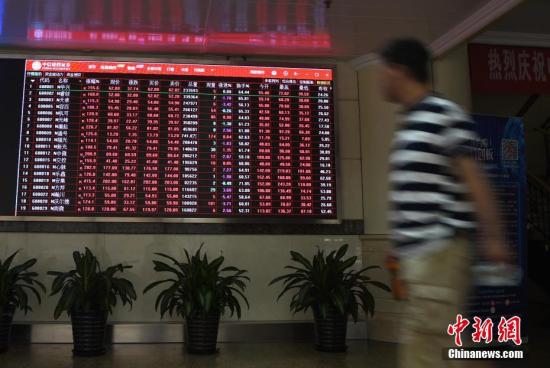(Economic Observation) 30 years of China's securities market: institutional innovation promotes "development"
China News Service, Shanghai, December 18 (Gao Zhimiao) Starting from 1990 and continuing to develop in 2020, China's securities market "stands on the thirties", stands on reforms, stands on innovation, and realizes "development" in the course of system innovation. Jump up".
Investors passed through the internal science and technology innovation board market information display of a securities business department in Beijing.
Photo by China News Agency reporter Hou Yu
Han Hanjun, deputy director and researcher of the Institute of Economics of the Shanghai Academy of Social Sciences, said in an interview with a reporter from China News Agency that the reform of equity split in 2005 and the reform of the registration system in 2019 are system innovations with landmark significance in the 30-year development of the securities market.
"The reform of non-tradable shares has solved the problem of the long-standing difference in the circulation system between non-tradable shares and tradable shares in the Chinese stock market that has plagued the development of the stock market, and has eliminated a major obstacle to the long-term stable development of the stock market. The pilot registration system has been promoted in other market sectors, and these reforms have removed obstacles to ultimately achieve complete marketization of the Chinese stock market.” Han Hanjun pointed out.
Wu Xiaoqiu, former vice president of Renmin University of China and dean of the China Capital Market Research Institute, also stated that the establishment of the Shanghai and Shenzhen Stock Exchange in 1990, the share-trading reform in 2005, and the registration reform in 2019 are the three major achievements in the 30-year history of China’s capital market development. Block "Monument".
Rui Meng, professor of finance and accounting at China Europe International Business School, told reporters that China's securities market has achieved a certain degree of "development leap" through 30 years of reform and development. He summarized the system evolution of these 30 years into four stages.
The period from 1990 to 1992 was the initial stage, the period from 1993 to 1998 was the stage of the approval system, and the period from 1999 to 2019 was the stage of the approval system. Currently, it is the registration system that is being piloted and promoted.
"From the perspective of the evolution of the company's listing and issuance system, this series of reforms has enabled the development of China's securities market from relatively young to relatively mature." Rui Meng said.
Fu Ziheng, general manager of Huaxin Securities Private Equity Research Center, also said that China’s securities market and China’s reform and opening up process "pulsate together", and the greatest value is the function of market-oriented equity financing and investment, price discovery, and asset allocation. The standardization and flow of property rights promoted the standardization and improvement of the internal governance structure of listed companies.
At the same time, the stock market has also catalyzed the enthusiasm for market entrepreneurship and innovation.
It is understood that in September 2020, the total number of listed companies in Shanghai and Shenzhen exceeded the 4,000 integer mark, and the total market value of listed companies in Shanghai and Shenzhen has reached 81.97 trillion yuan (RMB, the same below), compared with the “old company” listed in December 1990. The total market value of "eight shares" (the first 8 stocks listed) has increased by approximately 34,000 times, with a total market value of 2.382 billion yuan.
Rui Meng believes that from all aspects, the size of today's stock market has matched the size of the national economy, but there is still a long way to go from "large" to "strong", which is a systemic issue.
“Now the country’s growth model has changed from being driven by investment to driven by consumption and innovation, and the stock market also needs to keep pace with the times, whether it is from its issuance and listing system evolution or transaction system innovation. At the same time, listed companies must also be strong, and companies themselves must Continuous growth, of course, ultimately depends on China's real economy." Rui Meng said.
Facing the future, Han Hanjun believes that the further improvement and healthy development of China's securities market still need to accelerate the reform process in the areas of mergers and acquisitions and restructuring systems, information disclosure systems, and delisting systems.
"Reforms in these areas are not only the need to further improve and promote the registration system, but also the need to ultimately realize the complete marketization of the securities market."
Fu Ziheng also pointed out that future reforms need to focus on rule innovation at the trading level, such as lifting the price limit and implementing the T+0 trading system.
"Through innovation in the transaction system and other aspects, we will explore the construction of more institutional guarantees to better support the process of capital marketization."
China still has a long way to go to better integrate into the international capital market and become an important member of the international capital market. It is a systemic problem.
Rui Meng emphasized: “As for the regulatory agencies, once the system is in place, the implementation of the system must be in line with international standards. For financial institutions, more institutional investors must participate. For individual investors, residents must use the stock market as wealth management An important market for China. In the future, we will enter the era of equity, and we need to rely on equity assets to bring investors a steady stream of wealth." (End)

